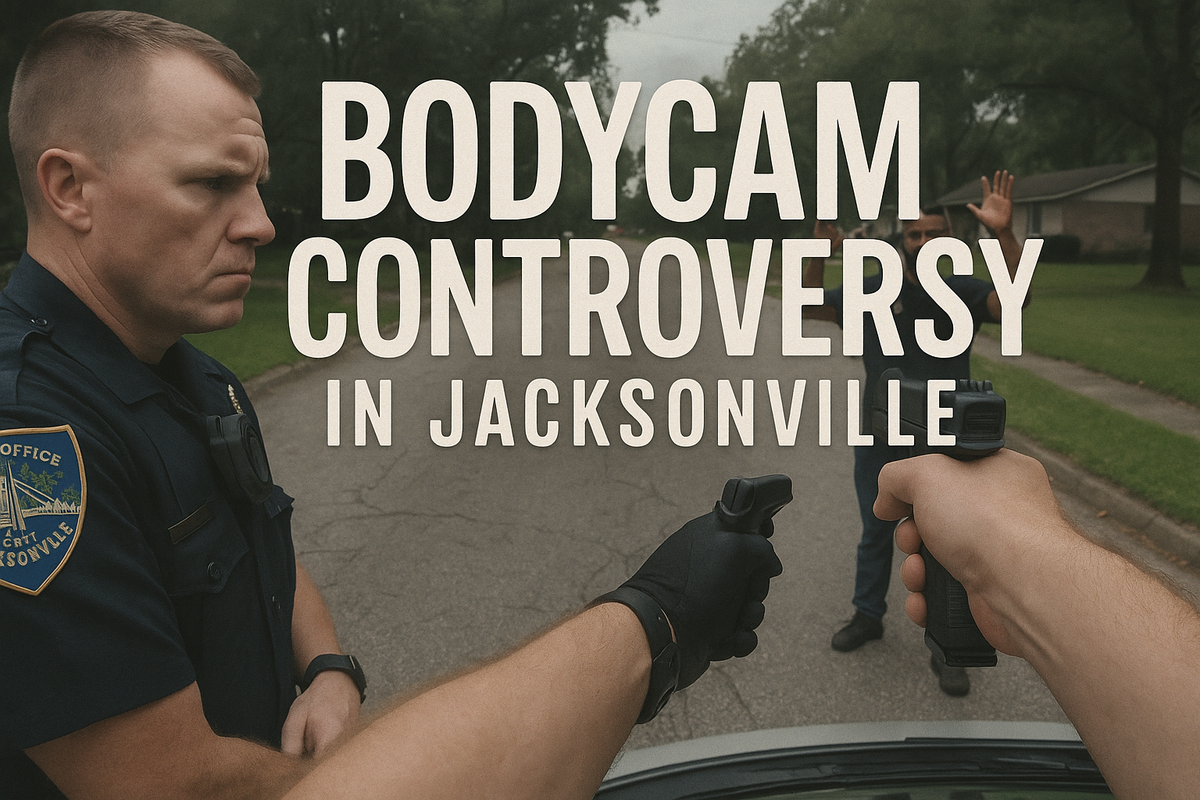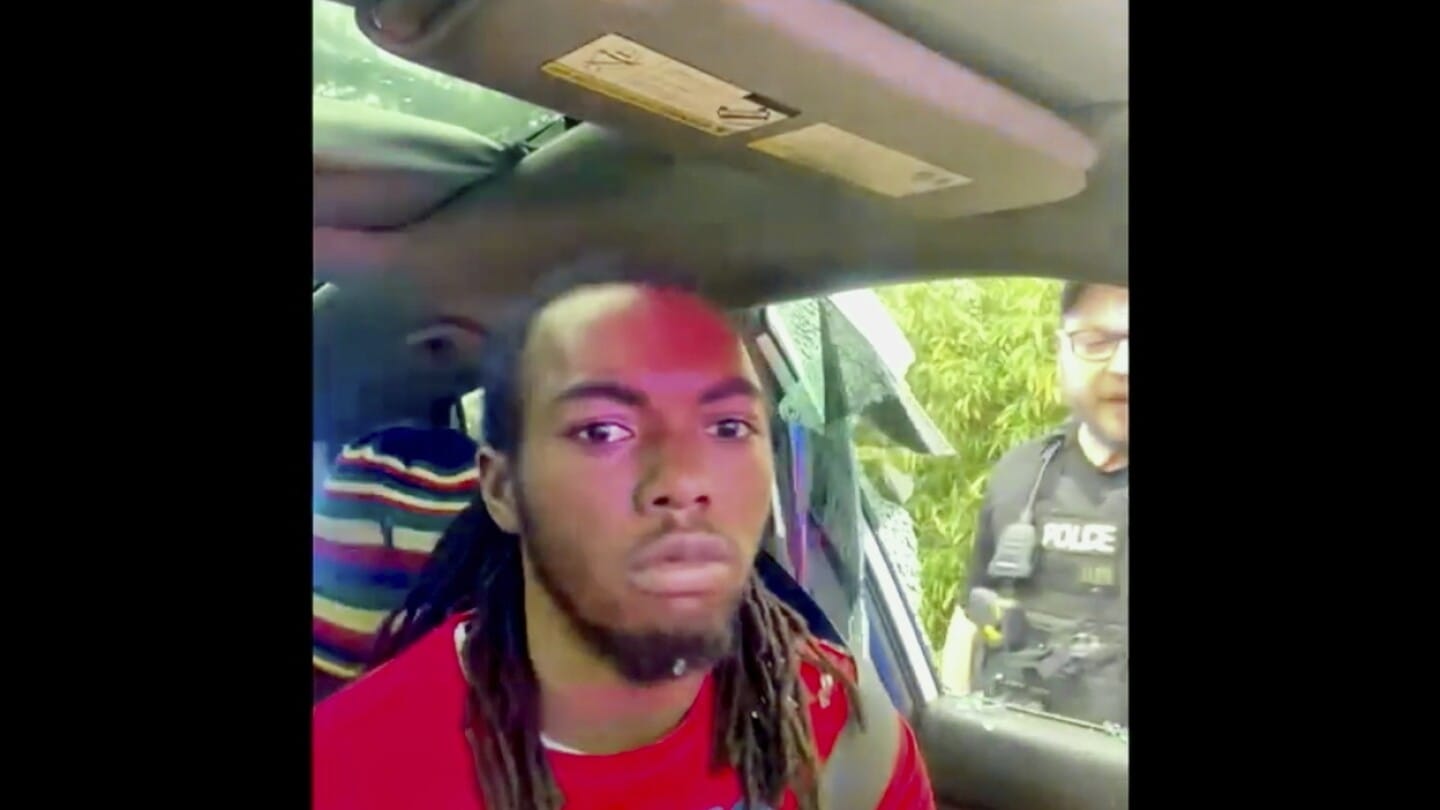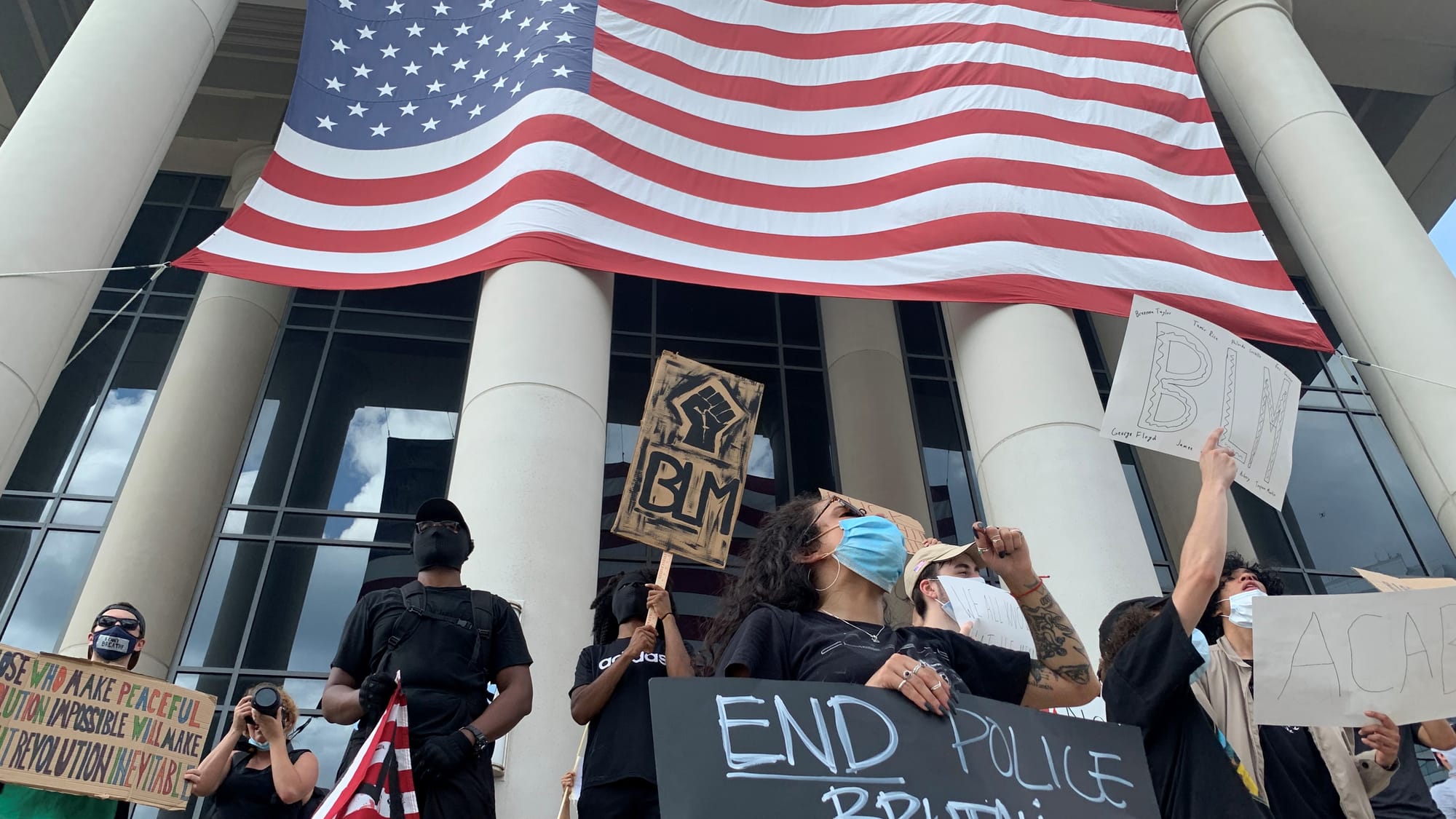Viral Traffic Stop Exposed: JSO Bodycam Footage of William McNeil Jr.'s Arrest Sparks National Outcry on Police Conduct
Explore the controversial police shooting of William Anthony McNeil Jr. in Jacksonville, Florida. This in-depth investigation analyzes bodycam footage, legal fallout, racial profiling concerns, and calls for justice in a case igniting national debate on police accountability.

Written by Lavanya, Intern, Allegedly The News
JACKSONVILLE, FL, July 24, 2025
The digital world is a crucible for truth and outrage. A single video, captured on a smartphone, can crack open a story that agencies might prefer to keep sealed. This is precisely what happened with the arrest of William Anthony McNeil Jr., a 22-year-old Black man from Jacksonville, Florida. A short, viral clip of his February traffic stop, a mere snippet of a much longer, more complicated encounter, sent shockwaves across the nation, sparking a familiar and painful debate about police conduct, use of force, and the lived reality of Black Americans.
In response to the viral firestorm, the Jacksonville Sheriff's Office (JSO) did something that has become increasingly common in the face of public pressure: they released the full body camera footage. What they intended as a clarifying, context-providing measure has instead become a complex text for public and legal scrutiny. The JSO’s footage, now available on their social media platforms and transparency portal, is not a simple refutation of the original video. Instead, it is a harrowing, minute-by-minute account of an escalating encounter that raises more questions than it answers, offering a stark and sometimes contradictory narrative to the one painted by the viral clip.
The Timeline of Tension: A Meticulous Breakdown of the JSO Bodycam Footage
The body camera footage, as released by the Jacksonville Sheriff’s Office, provides a crucial, if not entirely objective, perspective on the events of February 19th. The video begins with Officer D. Bowers approaching McNeil’s vehicle. According to the officer's initial report, the traffic stop was initiated because McNeil was driving without headlights or a seatbelt during what was described as "inclement weather." The footage shows McNeil initially opening his door, an action that seems to belie the later claim that he was entirely uncooperative from the start.
McNeil, who civil rights attorneys Ben Crump and Harry Daniels later identified as a biology student on a scholarship at a Historically Black College and University (HBCU), is seen in the footage engaging with the officer. The conversation is tense but initially calm. McNeil questions the reason for the stop, explaining that his headlights were off because it was still daylight and his window was not functioning, which is why he opened his door. The officer insists that state law requires headlights during inclement weather and demands to see McNeil's license and registration.
This is where the footage takes a pivotal turn. McNeil, seemingly frustrated and seeking clarification, asks the officer to "pull that law up" and to call a supervisor. This request, a common practice for citizens who feel they are being unjustly detained, is met with an immediate and firm rejection from the officer. The officer insists that McNeil must comply with his orders first, and only then will he entertain the request for a supervisor or legal clarification.
The tension ratchets up significantly as McNeil, now having closed and seemingly locked his car door, refuses to exit the vehicle without a supervisor present. The bodycam audio captures the officer repeatedly telling McNeil he is under arrest for "resisting an officer without violence." The camera's perspective, however, makes it difficult to see McNeil’s hands or his movements inside the vehicle. The police report would later claim that McNeil was "reaching for the floorboard of the vehicle where a large knife was sitting," a critical detail that the JSO's bodycam footage, due to its vantage point, does not clearly confirm or deny.
The next moments are a rapid and violent escalation. Other officers arrive on the scene. The officers surround the vehicle, and what happens next is the core of the controversy. One officer is heard shouting commands, and then, in a sudden, jarring sequence, the driver's side window is smashed. An officer's arm is thrust through the broken glass, and McNeil is struck in the face. The bodycam footage, while capturing the chaos, does not provide a clear view of the punch. It is only in McNeil's own viral cellphone footage that the blow is visible, a detail that has become central to the legal and public debate.
McNeil is then forcibly pulled from the vehicle. The footage shows officers wrestling him to the ground, with one officer delivering what another report would describe as six closed-fist punches to McNeil's hamstring. McNeil is heard on the footage, and in his own recording, repeatedly asking, "What is your reason?" as he is being subdued. The officers, in turn, are heard yelling, "Stop fighting!" and "You're under arrest!"
This chaotic, multi-minute sequence ends with McNeil on the ground, handcuffed, with a visible injury to his mouth and chin. The arrest is complete, but the story of the encounter is just beginning. The contrast between the JSO's bodycam, which presents a narrative of a non-compliant subject leading to the necessary use of force, and the viral video, which presents a calm man being met with unprovoked violence, is the defining chasm of this entire incident.

Who is William Anthony McNeil Jr.? A Profile of the Man Behind the Video
William Anthony McNeil Jr. is not just a face in a viral video; he is a 22-year-old college student with a life and future that have been profoundly impacted by this event. His attorneys, Ben Crump and Harry Daniels, have been quick to humanize him, pointing out that he is a dedicated student of biology and a member of his college's marching band. This detail is significant, as it runs counter to the "thug" narrative that is often used to justify police force against Black men.
The incident, which occurred on February 19, 2025, resulted in McNeil's arrest and a series of charges, including resisting an officer without violence, driving with a suspended license, possession of a small amount of cannabis, and citations for not wearing a seatbelt and having no headlights. According to Sheriff Waters, McNeil later pleaded guilty to the resisting and suspended license charges, which have been a key point in the JSO's defense of the officers' actions.
However, McNeil's legal team has contested this, highlighting that the plea bargain was made under duress and did not represent an admission of guilt for the actions that led to the use of force. They argue that the initial pretext for the stop, the headlights and seatbelt, was fabricated, pointing to the viral video in which McNeil is clearly wearing a seatbelt. Furthermore, they assert that the alleged "reaching for a knife" was a narrative invented after the fact to justify the officers’ extreme use of force.
McNeil himself has spoken out publicly, expressing his fear and confusion during the encounter. He described simply wanting to understand why he was being pulled over and why he had to exit the car. The physical and psychological toll has been severe, with his attorneys reporting that he suffered a concussion, short-term memory loss, a chipped tooth, and a lip injury that required nine stitches. The emotional trauma, he stated, has been a long and difficult road to recovery.
A Tale of Two Narratives: Public & Legal Reactions
The release of the bodycam footage did not, as JSO Sheriff T.K. Waters might have hoped, settle the public debate. Instead, it intensified it, creating a deep divide between those who believe the officers’ actions were justified and those who see them as a textbook case of police brutality.
The Official Response from the JSO:
Sheriff T.K. Waters held a press conference to release the bodycam footage, positioning it as an act of transparency. His central argument was that the viral video, captured on a cell phone from inside the car, lacked "context and depth." He argued that while the force used by the officers was "ugly," it was not necessarily "unlawful or contrary to policy." He emphasized that officers are required to comply with an officer's commands, regardless of whether they agree with the reason for the stop. Waters also pointed to the fact that the State Attorney's Office had cleared all involved officers of any criminal wrongdoing.
However, Sheriff Waters did not fully endorse the actions of Officer D. Bowers, the officer who initiated the stop and the use of force. He announced that Bowers had been "stripped of his law enforcement duties, effective immediately," pending the outcome of an internal administrative review. This decision, while a significant move towards accountability, did little to quell the outrage. For many, it felt like a half-measure, a compromise that fell short of a full condemnation and termination. The JSO’s statement, released after the public outcry, also noted that McNeil had never filed a formal complaint with the department, a detail that many critics saw as an attempt to shift blame.

The Legal and Public Counter-Narrative:
McNeil's legal team, led by nationally renowned civil rights attorney Ben Crump, quickly seized on the JSO's footage and statements. Crump and Daniels held their own press conference, where they laid out their case against the Jacksonville Sheriff's Office. They argued that the bodycam footage did not disprove their claims but rather underscored the culture of escalation and unnecessary force within the JSO. They highlighted the discrepancies between the police report and the video evidence, particularly the claim about the knife and the seatbelt.
Crump, known for his powerful rhetoric and commitment to racial justice, labeled the incident a "classic case of driving while Black." He argued that McNeil’s calm demeanor and simple requests for a supervisor were met with a violent and disproportionate response, a pattern he has seen in countless other cases. The legal team's position is that the officers' actions were not just an overreaction but a deliberate choice to use force against a person of color who dared to question authority. They have publicly stated their intention to pursue all legal options to ensure accountability, a clear signal that a major civil rights lawsuit is imminent.
The public reaction has been a firestorm of commentary across social media platforms, news articles, and local community forums. Many have expressed horror and outrage, with hashtags like #JusticeForWilliamMcNeil trending nationally. Others, particularly in the comments sections of news articles, have defended the police, arguing that McNeil's refusal to comply was the sole cause of the escalation. This deeply polarized public discourse reflects the broader national conversation on race, policing, and individual rights. The incident has become a flashpoint, a case study in how the same video evidence can be interpreted in wildly different ways depending on one's perspective and preconceptions about law enforcement.
The Unseen Story: Unpacking the Ethical & Social Justice Angles
The arrest of William McNeil Jr. is far more than a legal dispute; it is a profound ethical and social justice matter. It touches on long-standing issues of racial profiling, police accountability, and the power dynamics inherent in law enforcement interactions.
Racial Profiling and the Pretextual Stop
The initial reason for the traffic stop - a headlight violation in daylight and a seatbelt violation has been a major point of contention. McNeil’s attorneys argue that this was a pretextual stop, a legal maneuver where police use a minor traffic violation as a justification to stop and investigate an individual, often based on their race. The very idea that a minor, debatable infraction could lead to a violent arrest and severe injuries is at the heart of the "driving while Black" argument. For many in the Black community, this incident is a painful reminder that even the most benign interaction with police can spiral into a life-altering or life-ending event.
The Chasm of Accountability
The legal outcome that the State Attorney's Office found no criminal wrongdoing has been a bitter pill for many to swallow. It highlights a critical systemic issue: the high bar for proving criminal misconduct by law enforcement officers. Even with video evidence, the "reasonable officer" standard often shields officers from prosecution. This creates a deeply frustrating cycle where police are investigated internally and sometimes disciplined, but rarely held criminally accountable for actions that, if committed by a civilian, would lead to immediate incarceration. The JSO's decision to strip Officer Bowers of his duties is a form of administrative accountability, but for many, it falls far short of justice.
The Power of Perspective
The contrasting videos, McNeil’s viral clip and the JSO’s bodycam footage, are not just two different angles on the same event. They represent two fundamentally different perspectives on the world. The JSO’s footage, despite its imperfections, is meant to show the officer’s point of view, emphasizing the threat and the need for compliance. McNeil's video, however, is a first-person account of a person who is trying to assert his rights and is met with violence. The fact that the punch is clearly visible in one but not the other is a powerful metaphor for how these incidents are seen: what is clear and undeniable to a civilian is often obscured and debatable from the law enforcement perspective. This disparity in perspective is not just an issue of camera placement; it's a matter of institutional and individual trust.
The Broader Context of Policing in America
This incident in Jacksonville does not happen in a vacuum. It is part of a national conversation about the need for police reform. It raises questions about de-escalation training, use-of-force policies, and the culture of policing itself. It compels us to ask if the current system is designed to protect and serve all citizens equally, or if it is a system that disproportionately targets and harms marginalized communities. The McNeil case is a microcosm of these larger debates, a reminder that the fight for racial justice and police accountability is far from over.
Accountability or Justification?
The release of the JSO bodycam footage of William Anthony McNeil Jr.'s arrest has not provided a definitive answer to the question of what happened on that February day. Instead, it has laid bare the deep-seated divisions in our society regarding policing, race, and justice. The full footage complicates the narrative of the viral clip, yet it also undeniably confirms the use of extreme force against a man who was, by all accounts, not an immediate threat.
McNeil’s story is a call to action, a demand for deeper scrutiny, not just of this single incident, but of the entire system of policing that allows such encounters to happen. It forces us to confront the uncomfortable truth that while technology can provide more transparency, it cannot, on its own, create accountability. That responsibility belongs to us, the public, to demand reform and to hold our institutions to a higher standard of justice and fairness for all.
The Real Debate Starts Now
How do the two videos - McNeil’s cell phone footage and the JSO’s bodycam shape your understanding of the events? The State Attorney's Office cleared the officers of criminal wrongdoing, yet the JSO stripped one officer of his duties. What does this tell you about the difference between criminal accountability and internal departmental accountability? Is this sufficient? What policy changes, if any, could have prevented this incident from escalating in this way?
Sources
- JSO Press Conference/Bodycam Footage
- Ben Crump Law Press Release
- Local news coverage (e.g., First Coast News)
- Legal analysis of the use of force laws
- Scholarly article on pretextual stops
- AP Photo/Allen G. Breed
- News4JAX




